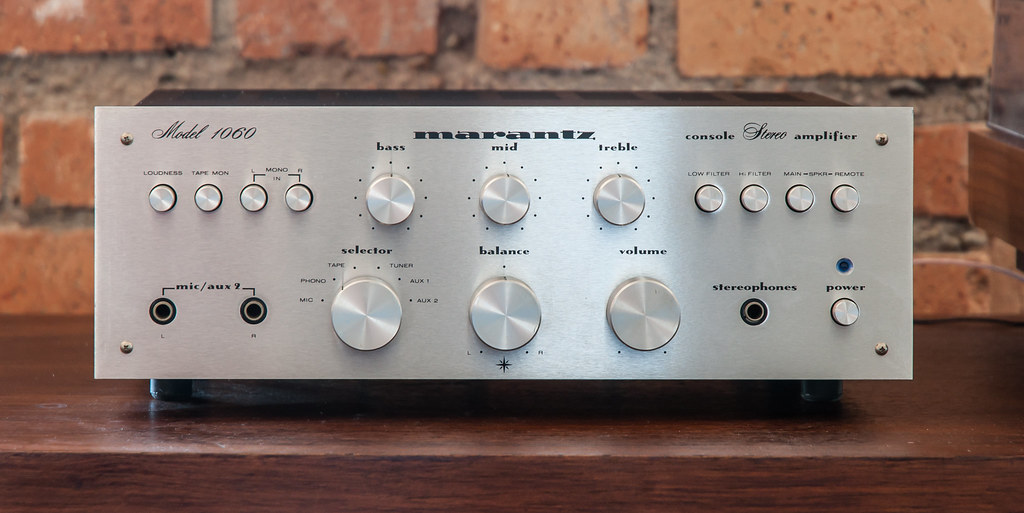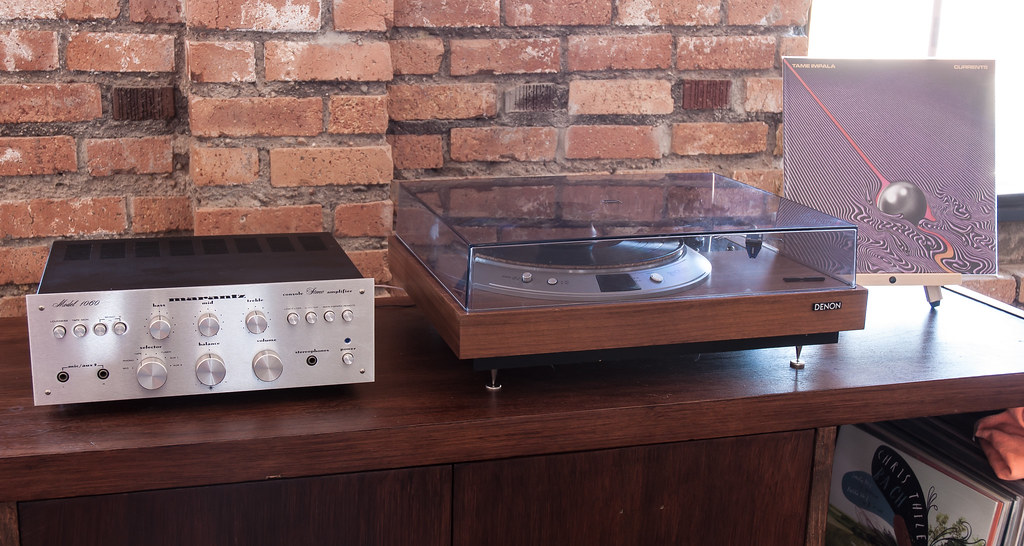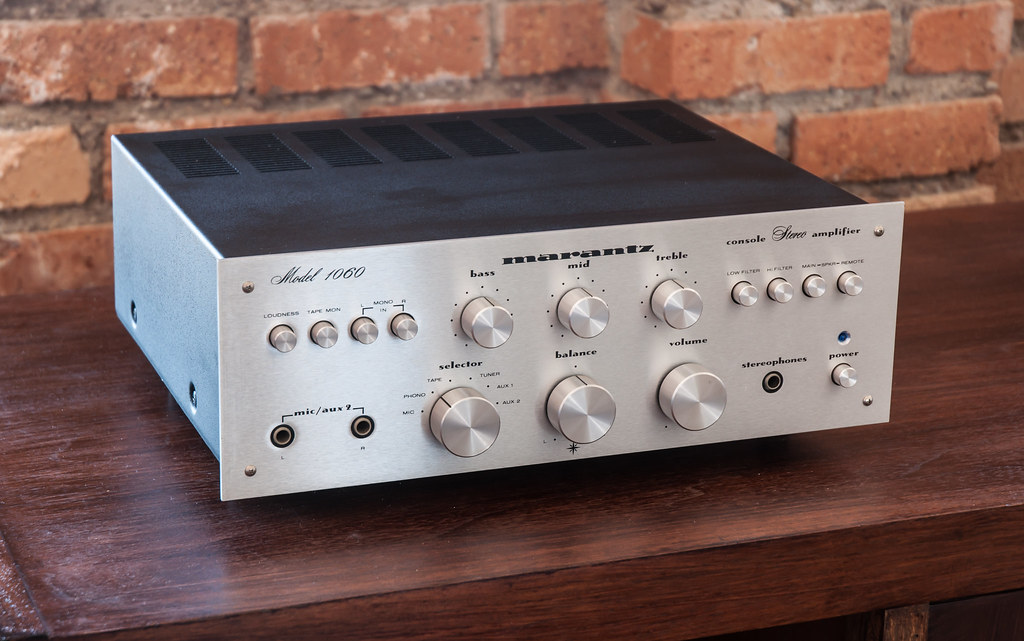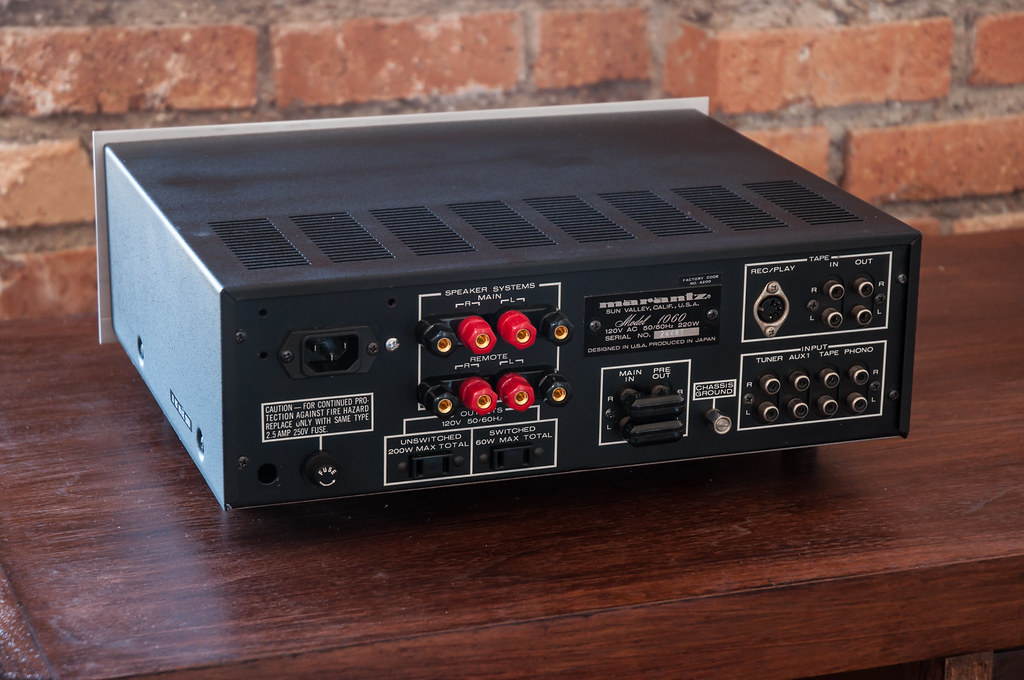ictwoody
I like vintage gear — my preamp is from 2007.
I felt like this forum was an appropriate place for this. 
I've always felt like the diminutive Marantz 1060 was a special amp in the lineup. The 30wpc is enough to power a good variety of speakers, and there is just something really "right" with the way is sounds.
The very first piece of gear I bought when I got into this hobby was a Marantz 1060. Being a designer by trade, I just saw a picture of one online somewhere, probably on some architectural interiors blog, and the perfectly symmetrical face just hooked me and I needed to get one. I purchased a nice example off of eBay back in about 2007. That's when I got hooked on audio.
I really liked the Marantz house sound for a while. I considered my self a "Marantz guy." I owned a 2230, a couple 2015's, a 250M/3600/120 stack, another 1060, some Marantz speakers, 6100 and 6300 turntables and probably some other pieces I'm forgetting, before venturing into the world of Kenwood, Pioneer and some others.
After sliding down the slippery slope that is hifi for quite some time I've kinda settle down... mostly in slightly higher-end, "high-value" modern pieces. But there was part of me that REALLY missed that little 1060 which I had sold off to fund the next thing. Well not too long ago I came across a fair deal on a really clean 1060 with the original box and packing, but with what the previous owner told me was a weak channel. I got the unit and it proceeded to sit in its box for over a year, until just recently.
Through some round-about conversations on AK, I decided that I wanted to have this amp FULLY restored. I had sold off two other 1060's and I decided that this one was going to stay, so I wasn't too worried about getting "upside down" in it by spending the cash to have it done up. I chose AKer and super-nice dude Bill Hirsch to do the work. Bill has been awesome and would 100% recommend him to anyone needing stuff worked on.
I got the amp back from Bill last week and today I finally hooked it up to my big Klipsch speakers and it sound AMAZING. This amp has one of the lowest, if not the lowest noise floor of any vintage pieces I've owned. Simple fantastic.
The reason I put this in the "Vintage Gear - Performance" forum is because of the restoration, and more importantly the mods.
Bill recapped the entire unit including replacing all of the electrolytic caps, replacing the main filter cap with a larger 6800mfd unit. He replaced all of the transistors in the preamp and tone control section with upgraded versions. The transistors in the phono section were replaced and he also changed the loading resistors from 100k to 47k which is more appropriate for current MM carts. He said the 100k was a late model change Marantz did because of some quad carts that were in-vogue at the time. The power supply diodes were replaced with ultrafast soft recovery diodes to reduce the noise floor. All of the signal path ceramic caps were replaced and all the signal path resistors were as well. He de-soldered and re-soldered all the joints on the amp and preamp sections as well as giving the amp a thorough cleaning, dexoit bath, 20+ hr burn in and fully adjusted it back to spec per the Marantz service manual. Whoo. That's a lot.
At it's rated output of 30wpc he said the distortion numbers are immeasurable, and at it's rated distortion this baby is cranking out 41wpc. Not to shabby!
The last of the mods that have been done are that I had swapped the cover with a black cover off of a Marantz 110 tuner I had for a more modern look, and Bill replaced the crappy factory binding spring clips with some 5-way posts I provided. He then removed the stock power cord and installed a new IEC connector. He also added some softer rubber feet which add just a bit of height and I'm totally sure they isolate the unit in a vastly superior way than the factory feet — but mostly cause my factory feet were missing.
These mods are awesome cause it makes this amp more like a modern integrated in the sense of how fast swapping it in and out of a system can be by using the power cord and banana speaker cables that are already right there in place.
Okay... I've rambled on enough. Here's the pics... I know that's all you guys clicked on the thread for anyway.
- Woody




I've always felt like the diminutive Marantz 1060 was a special amp in the lineup. The 30wpc is enough to power a good variety of speakers, and there is just something really "right" with the way is sounds.
The very first piece of gear I bought when I got into this hobby was a Marantz 1060. Being a designer by trade, I just saw a picture of one online somewhere, probably on some architectural interiors blog, and the perfectly symmetrical face just hooked me and I needed to get one. I purchased a nice example off of eBay back in about 2007. That's when I got hooked on audio.
I really liked the Marantz house sound for a while. I considered my self a "Marantz guy." I owned a 2230, a couple 2015's, a 250M/3600/120 stack, another 1060, some Marantz speakers, 6100 and 6300 turntables and probably some other pieces I'm forgetting, before venturing into the world of Kenwood, Pioneer and some others.
After sliding down the slippery slope that is hifi for quite some time I've kinda settle down... mostly in slightly higher-end, "high-value" modern pieces. But there was part of me that REALLY missed that little 1060 which I had sold off to fund the next thing. Well not too long ago I came across a fair deal on a really clean 1060 with the original box and packing, but with what the previous owner told me was a weak channel. I got the unit and it proceeded to sit in its box for over a year, until just recently.
Through some round-about conversations on AK, I decided that I wanted to have this amp FULLY restored. I had sold off two other 1060's and I decided that this one was going to stay, so I wasn't too worried about getting "upside down" in it by spending the cash to have it done up. I chose AKer and super-nice dude Bill Hirsch to do the work. Bill has been awesome and would 100% recommend him to anyone needing stuff worked on.
I got the amp back from Bill last week and today I finally hooked it up to my big Klipsch speakers and it sound AMAZING. This amp has one of the lowest, if not the lowest noise floor of any vintage pieces I've owned. Simple fantastic.
The reason I put this in the "Vintage Gear - Performance" forum is because of the restoration, and more importantly the mods.
Bill recapped the entire unit including replacing all of the electrolytic caps, replacing the main filter cap with a larger 6800mfd unit. He replaced all of the transistors in the preamp and tone control section with upgraded versions. The transistors in the phono section were replaced and he also changed the loading resistors from 100k to 47k which is more appropriate for current MM carts. He said the 100k was a late model change Marantz did because of some quad carts that were in-vogue at the time. The power supply diodes were replaced with ultrafast soft recovery diodes to reduce the noise floor. All of the signal path ceramic caps were replaced and all the signal path resistors were as well. He de-soldered and re-soldered all the joints on the amp and preamp sections as well as giving the amp a thorough cleaning, dexoit bath, 20+ hr burn in and fully adjusted it back to spec per the Marantz service manual. Whoo. That's a lot.
At it's rated output of 30wpc he said the distortion numbers are immeasurable, and at it's rated distortion this baby is cranking out 41wpc. Not to shabby!
The last of the mods that have been done are that I had swapped the cover with a black cover off of a Marantz 110 tuner I had for a more modern look, and Bill replaced the crappy factory binding spring clips with some 5-way posts I provided. He then removed the stock power cord and installed a new IEC connector. He also added some softer rubber feet which add just a bit of height and I'm totally sure they isolate the unit in a vastly superior way than the factory feet — but mostly cause my factory feet were missing.
These mods are awesome cause it makes this amp more like a modern integrated in the sense of how fast swapping it in and out of a system can be by using the power cord and banana speaker cables that are already right there in place.
Okay... I've rambled on enough. Here's the pics... I know that's all you guys clicked on the thread for anyway.
- Woody






